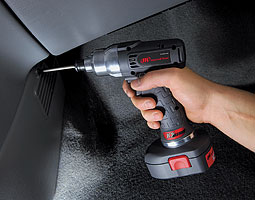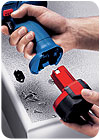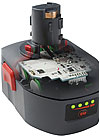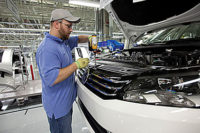
Today, cordless tools are used for a wide variety of screwdriving tasks on many different types of assembly lines. While they are stronger, lighter and more popular than ever, cordless tools are still restricted by battery power, weight and durability.
Cordless devices represent the fastest-growing segment of the power tool market. During the last few years, demand for battery-powered impact drivers, torque wrenches and other production tools has outpaced demand for traditional pneumatic and corded electric devices.
Several factors have contributed to this phenomenon. Cordless, battery-powered tools offer unique advantages for assemblers. For instance, they can fit in tight spaces where an umbilical, such as an air hose or electrical cord, may restrict easy access and maneuverability.
Cordless tools help eliminate headaches on the plant floor associated with cords, cables and hoses. Air hoses and electrical cords stretched across a work area pose trip hazards. In fact, a recent report conducted by the National Council on Compensation Insurance Inc. (Boca Raton, FL) cites the increased use of cordless tools as one of the top reasons for a significant decline in workers’ compensation claims in recent years.
Eliminating pesky cords and hoses can also help assemblers with lean manufacturing initiatives by improving efficiency and eliminating sources of waste. Operators often consume valuable production time detangling cords or hoses when they get snagged on workstations, parts bins, fixtures, tool carts and other items.
In addition, cordless tools are much quieter than pneumatic equipment. And, they allow assemblers to work more easily on platforms, inside vehicles and other awkward places where space is at a premium, and where taut cords and hoses can scratch or mar surfaces. Operators can freely walk up and down an assembly line without worrying about dragging an umbilical behind them.
The latest generation of cordless tools can perform as good as or better than many air tools and DC electric tools available on the market. Recent improvements in motors, clutches and controls have created energy-efficient alternatives to traditional fastening tools. For instance, some cordless tools are more repeatable, because they don’t rely on constant air pressure or flow.
Improved battery technology has also spurred demand for cordless production tools. Today’s rechargeable batteries are more durable than ever, providing more power and significantly longer run times. But, batteries remain a hurdle to widespread acceptance of cordless screwdriving. Batteries typically comprise one-third of the weight and 50 percent of the cost of a cordless tool.
Tool manufacturers have been working with their battery suppliers to develop increased capacity, which results in longer run times, with negligible weight and size. The universal goal is to develop a cordless tool that can do the same speeds and torques as an air tool for about the same weight as an air tool with its hose.
Traditionally, only a handful of companies have made batteries for assembly applications. The market is dominated by manufacturers such as Matsushita Electric Industrial Co. (Osaka, Japan), Sanyo Electric Co. (Osaka, Japan) and Sony Corp. (Tokyo). But, things are starting to change.
“This is an exciting time in the development of batteries,” says Chris Turner, director of battery technology at Nexergy Inc. (Columbus, OH), a battery pack systems integrator that works with several different battery cell manufacturers and tool manufacturers. “In the last couple of years, we have seen a diversification in lithium-ion development led by relatively small companies, such as A123 Systems Inc. (Watertown, MA) and Boston-Power Inc. (Westborough, MA), that have developed technologies to address specific market needs; in particular, those areas where the big manufacturers were not focused.”
For instance, A123 is a start-up that was the first company to focus entirely on high-rate applications, such as the power tool market. The company’s R&D efforts are based in the United States, but it assembles battery cells in China.
Rechargeable battery manufacturers have been developing new technologies that make it possible to get more energy into individual cells, which in turn allows for longer run-times. “The primary trend in battery technologies continues to be on extending run times, with sufficient power, while maintaining or even reducing the physical size and weight of the cell,” says Steve Tayler, vice president of business development for aerospace and assembly at Makita USA Inc. (La Mirada, CA).
Traditionally, cordless tools have used nickel-cadmium or nickel-metal hydride batteries. But, the industry is quickly converting to various lithium-ion chemistries developed by the consumer electronics industry for laptop computers and cell phones.

Cordless tool manufacturers have fallen in love with lithium-ion batteries, which provide an attractive power-to-weight ratio.
Lithium Lust
Within the last 2 years, cordless tool manufacturers have fallen in love with lithium, which is the lightest metal. “This is driven by size, weight and recycling demands,” says Ken Maio, product development manager at AIMCO (Portland, OR). “Lithium provides a better power-to-weight ratio and can allow a tool to run on a physically smaller pack than it has been able to in the past.”The relatively fast transition to this new battery chemistry has been enabled by the development of reliable high discharge rate lithium-ion technology. “It is important to make a distinction between high rate lithium-ion and the historically more conventional high energy density lithium-ion used in laptops and other consumer electronics,” notes Turner. “High-rate lithium trades off significant energy density for high-rate capability and it’s what is typically used in the industrial tool market.
“From a chemistry point of view, nickel-cadmium and nickel-metal hydride cells that have historically been used [for cordless tools] are very robust and can handle an assortment of abuses,” adds Turner. “Lithium-ion, in general, needs to be managed electronically and mechanically to ensure safe, reliable, long-term operation.”
Lithium-ion battery packs are more complex and require extra assembly steps than other types of batteries, which results in a higher price tag. “Typically, lithium-ion cells are twice as expensive as nickel-cadmium cells,” says Christian Corrigan, global marketing manager for cordless tools at Ingersoll Rand Productivity Solutions (Annandale, NJ).
However, because lithium is lighter than nickel-based alternatives, lithium-ion cells reduce battery weight and volume by more than 30 percent. “The new chemical compound and new housing material has reduced the size and weight of the battery,” explains Dwayne Dupuis, product line manager for electric assembly at Cooper Power Tools (Lexington, SC). “In the last five years, weight and size have been reduced by 25 percent to 30 percent.”
While weight is still a concern to cordless tool users, new battery technology is making it less of an issue than in the past. “The goal is still a lighter battery that outperforms today’s cells,” notes William Staiger, manager of marketing and product development at Bosch Production Tools North America (Mount Prospect, IL). “Getting rid of weight usually means losing amperage and run-time capacity, so this is still the trade-off. Different manufacturers use different theories to deal with this problem.
“Weight is becoming a non-issue, especially as the tools become more efficient and require less power to do the same work,” claims Staiger. “Bosch is very close to that goal with many existing cordless assembly tools and will get even closer to it in the future.”
“Since ergonomic and safety concerns are an ever-increasing area of focus in facility cost reduction, ensuring that [an assembler] is operating a comfortable tool has become more and more important,” adds Tayler. “Keeping total weight to a minimum is favorable, as the operator will endure less stress in tool operation over time.”
Tayler claims that Makita’s ongoing migration away from nickel-cadmium to nickel-metal hydride and on to lithium-ion has provided users a 300 percent gain in productivity output, while actually reducing the weight of the tool when comparing tools using the same voltage.
“For example, our 14.4-volt, 3-amp-hour lithium-ion batteries weigh 18 percent less than our 12-volt, 2-amp nickel-metal hydride cells, while increasing run times by approximately 50 percent,” he points out. “The weight is even further reduced when comparing lithium-ion to the nickel-cadmium dinosaurs of the past. Each transition in technology has resulted in higher productivity output levels.”
Despite these advantages, not all cordless tool manufacturers have jumped onto the lithium-ion bandwagon. For instance, Bosch Production Tools is following a different strategy than many of its competitors. “Others have chosen to move toward new technologies, but the fact is that these technologies do not outperform what Bosch is currently using,” claims Staiger. “We will have lithium-ion eventually, but not now.
“[We have] chosen not to move in this direction yet, because lithium-ion batteries simply do not have the current capacity and deep cycle capacity for the assembly environment,” adds Staiger. “Even though some of our [cordless construction and consumer] tools are now using lithium-ion technology, [the production tool side] still uses Class 0 nickel-cadmium cells. They still outperform any other battery technology currently on the market.”
Bosch has focused its R&D efforts on other areas, such as clutch technology and wireless controls. Staiger claims that lithium-ion only makes sense today in tools that are not run continuously, such as those marketed through home centers, hardware stores and other retail channels.
According to Staiger, there’s a dramatic difference between a lithium-ion battery and a Class 0 nickel-cadmium battery. “Class 0 cells are built to a tighter tolerance than Class 1 and Class 2 NiCad batteries, which are intended for professional tools and do-it-yourself tools, respectively,” he points out. A Class O can achieve 3,000 charge cycles with a run time that is typically much longer than other cordless assembly tools.”
When choosing cordless tools, Staiger says manufacturing engineers should distinguish between professional tools, which are used off and on throughout a shift, and production tools, which are constantly in use. “Look for batteries that provide the longest run time, the best deep-cycle performance and the most number of charges before disposal,” he suggests. “There is only one choice: a Class 0 Ni-Cad.”

Rechargeable battery manufacturers have been finding new ways to pack more energy into smaller cells.
Motors Are Important
In addition to batteries, motors, drivetrains and chargers are also important considerations. “It really isn’t just about the battery,” says Makita’s Tayler. “With each advance in battery technology, changes to charging system strategies and motor technologies are very important considerations in tool design in order to maximize productivity.“The focus of cordless trends have typically revolved around battery technologies, and these have usually been the lightning rod topic when a new product is launched,” adds Tayler. “[Often overlooked is the fact that] motors have been designed to be smaller and more efficient, while battery chargers have been designed to be smarter and work faster.”
Motors determine how much power is pulled from the battery. They determine overall energy consumption and efficiency. “The more efficient your motor is, the less demand you require from your battery,” explains Tayler. “Our motors, which we manufacture in-house, are getting smaller, with higher outputs.”
By using more energy-efficient motors, tool makers are now able to use a 9-volt battery to achieve 12 newton-meters of torque. In the past, that would have required a 12-volt battery that generated much more heat.
Many cordless tool manufacturers are starting to offer brushless motors, which require less maintenance. They eliminate friction and create a more efficient transfer of energy. “As motor performance and efficiency improves, less voltage and current is required to run the tool,” says Staiger, whose company is coming out with a line of cordless tools equipped with brushless motors later this year.
When evaluating cordless tools, manufacturing engineers should focus on more than just the battery issue. “A big myth is that battery performance is the only factor to consider in how well a tool performs,” notes AIMCO’s Maio. “The motor, or tool engine, efficiency greatly affects how long a tool runs on a single charge. Inefficient brush-type motors consume more energy as they wear and as brush dust accumulates.
“The most robust battery will run down more quickly when coupled to an energy-demanding motor,” warns Maio. “Many times, a user will blame the battery when, in fact, the motor needs maintenance or replacement.”

Improved battery technology has spurred demand for cordless production tools.
Future Technology
No matter what type of cordless tool is used, there will always be a demand for batteries that last longer, but weigh less. “This is an on-going challenge [faced] by all major companies involved in supplying professional-grade products to the manufacturing environment,” says Tayler.
Many current R&D efforts in the battery industry are being driven by a huge demand from the automotive and consumer electronics industries. But, those developments will eventually trickle down to cordless tool applications.
“Higher power levels, longer run-times per charge and longer lifetime cycle expectations will continue to be targeted,” says Tayler. “Since lithium-ion technology is still relatively new in manufacturing, we don’t expect a new platform to evolve within the next few years.”
However, researchers are busy investigating next-generation alternatives. “Nanotechnology and thin-film battery technology may play a part in advancing today’s rechargeable lithium-ion batteries,” says Sara Bradford, industry director of the energy and power systems group at Frost & Sullivan Inc. (San Antonio). “Each process provides benefits such as a smaller footprint, lighter weight, and more electrical conversion from the chemicals, which results in a higher energy density.”
In the future, Bradford believes battery manufacturers will develop chemistries that are even more durable and efficient than today’s products. For instance, new technology will explore ways that cordless tools can pull more energy out of their batteries, faster. And, battery capacity will continue to increase, expanding amp-hours while decreasing size.
Lithium-sulfur is one technology that Bradford says could deliver very high energy density, which would enable smaller, lighter, longer-running batteries. Sion Power Corp. (Tucson, AZ) has developed a battery that incorporates a liquid cathode and uses the thin-film deposition technique for 75 percent of its cell components. “The usage of sulfur and innovative manufacturing techniques aids in minimizing the cost,” Bradford points out.
Lithium-polymer is a promising technology that may allow manufacturers to mold batteries into shapes other than traditional squares and rectangles. “The next trend will be to stuff batteries inside the handle of power tools,” predicts Ingersoll Rand’s Corrigan. However, lithium-polymer is currently only available for low-voltage applications, such as small electronic devices.
Silver-zinc batteries may eventually challenge lithium-ion in the battle for energy density. In fact, they offer up to 40 percent more power. The batteries are based on intrinsically safe water-based chemistry, and contain no lithium or flammable solvents. Unlike lithium-ion and lithium-polymer batteries, silver-zinc batteries eliminate the problems of overheating, fire and possible explosion. ZPower Inc. (Camarillo, CA) is currently ramping up to mass-produce batteries for applications such as notebook computers and cell phones.
Fuel cells have the potential to deliver more energy per volume weight than conventional batteries. While micro fuel cells are still being developed, Bradford expects them to be available for consumer electronics and military applications within 5 years. But, she does not expect them to be used for industrial applications, such as cordless power tools, until around 2015. “Direct methanol fuel cells are likely to be a strong contender, although hydrogen-based or reformed methanol formats are likely to produce more power output,” notes Bradford.
According to Nexergy’s Turner, energy harvesting will also become a well-known concept during the next few years. “It will overtake fuel cells as the ‘next big thing’ that will replace batteries,” he predicts. The concept of energy harvesting refers to using natural sources, such as light, heat or motion, to generate energy.
Early applications of the technology have been used to continuously power and recharge small, low-power electronic devices, such wristwatches. Energy is generated by normal daily motion or a heat flow source, such as the user’s wrist.
Go to "Web Extra" to learn more about battery trends.
Many current R&D efforts in the battery industry are being driven by a huge demand from the automotive and consumer electronics industries. But, those developments will eventually trickle down to cordless tool applications.
“Higher power levels, longer run-times per charge and longer lifetime cycle expectations will continue to be targeted,” says Tayler. “Since lithium-ion technology is still relatively new in manufacturing, we don’t expect a new platform to evolve within the next few years.”
However, researchers are busy investigating next-generation alternatives. “Nanotechnology and thin-film battery technology may play a part in advancing today’s rechargeable lithium-ion batteries,” says Sara Bradford, industry director of the energy and power systems group at Frost & Sullivan Inc. (San Antonio). “Each process provides benefits such as a smaller footprint, lighter weight, and more electrical conversion from the chemicals, which results in a higher energy density.”
In the future, Bradford believes battery manufacturers will develop chemistries that are even more durable and efficient than today’s products. For instance, new technology will explore ways that cordless tools can pull more energy out of their batteries, faster. And, battery capacity will continue to increase, expanding amp-hours while decreasing size.
Lithium-sulfur is one technology that Bradford says could deliver very high energy density, which would enable smaller, lighter, longer-running batteries. Sion Power Corp. (Tucson, AZ) has developed a battery that incorporates a liquid cathode and uses the thin-film deposition technique for 75 percent of its cell components. “The usage of sulfur and innovative manufacturing techniques aids in minimizing the cost,” Bradford points out.
Lithium-polymer is a promising technology that may allow manufacturers to mold batteries into shapes other than traditional squares and rectangles. “The next trend will be to stuff batteries inside the handle of power tools,” predicts Ingersoll Rand’s Corrigan. However, lithium-polymer is currently only available for low-voltage applications, such as small electronic devices.
Silver-zinc batteries may eventually challenge lithium-ion in the battle for energy density. In fact, they offer up to 40 percent more power. The batteries are based on intrinsically safe water-based chemistry, and contain no lithium or flammable solvents. Unlike lithium-ion and lithium-polymer batteries, silver-zinc batteries eliminate the problems of overheating, fire and possible explosion. ZPower Inc. (Camarillo, CA) is currently ramping up to mass-produce batteries for applications such as notebook computers and cell phones.
Fuel cells have the potential to deliver more energy per volume weight than conventional batteries. While micro fuel cells are still being developed, Bradford expects them to be available for consumer electronics and military applications within 5 years. But, she does not expect them to be used for industrial applications, such as cordless power tools, until around 2015. “Direct methanol fuel cells are likely to be a strong contender, although hydrogen-based or reformed methanol formats are likely to produce more power output,” notes Bradford.
According to Nexergy’s Turner, energy harvesting will also become a well-known concept during the next few years. “It will overtake fuel cells as the ‘next big thing’ that will replace batteries,” he predicts. The concept of energy harvesting refers to using natural sources, such as light, heat or motion, to generate energy.
Early applications of the technology have been used to continuously power and recharge small, low-power electronic devices, such wristwatches. Energy is generated by normal daily motion or a heat flow source, such as the user’s wrist.
Go to "Web Extra" to learn more about battery trends.

